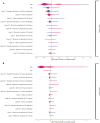Machine Learning Algorithm to Predict Atrial Fibrillation Using Serial 12-Lead ECGs Based on Left Atrial Remodeling
- PMID: 39344663
- PMCID: PMC11681470
- DOI: 10.1161/JAHA.123.034154
Machine Learning Algorithm to Predict Atrial Fibrillation Using Serial 12-Lead ECGs Based on Left Atrial Remodeling
Abstract
Background: We hypothesized that analysis of serial ECGs could predict new-onset atrial fibrillation (AF) more accurately than analysis of a single ECG by detecting the subtle cardiac remodeling that occurs immediately before AF occurrence. Our aim in this study was to compare the performance of 2 types of machine learning (ML) algorithms.
Methods and results: Standard 12-lead ECGs of patients selected by cardiologists between January 2010 and May 2021 were used for ML model development. Two ML models (single ECG and serial ECG) were developed using a light gradient boosting machine-learning algorithm. Model performance was evaluated based on the area under the receiver operating characteristic curve, sensitivity, specificity, accuracy, and F1 score. We trained the ML models on 415 964 ECGs from 176 090 patients. When testing the 2 ML models using external validation data sets, the performance of the serial-ML model was significantly better than that of the single-ML model for predicting new-onset AF (single- versus serial-ML model: sensitivity 0.744 versus 0.810; specificity 0.742 versus 0.822; accuracy 0.743 versus 0.816; F1 score 0.743 versus 0.815; area under the receiver operating characteristic curve 0.812 versus 0.880; P<0.001). The Shapley Additive Explanations analysis ranked P-wave duration and amplitude among the top 10 ECG parameters.
Conclusions: An ML model based on serial ECGs from an individual had greater ability to predict new-onset AF than the ML model based on a single ECG. P-wave morphologies were associated with future AF prediction.
Keywords: ECG; artificial intelligence; atrial fibrillation; machine learning; prediction; remodeling.
Figures







References
MeSH terms
LinkOut - more resources
Full Text Sources
Medical

